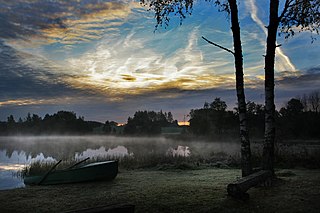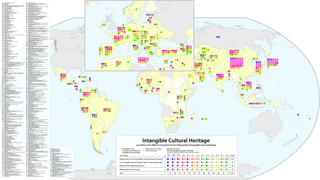
Polyphony is a type of musical texture consisting of two or more simultaneous lines of independent melody, as opposed to a musical texture with just one voice (monophony) or a texture with one dominant melodic voice accompanied by chords (homophony).

Overtone singing, also known as overtone chanting, harmonic singing, polyphonic overtone singing, or diphonic singing, is a set of singing techniques in which the vocalist manipulates the resonances of the vocal tract to arouse the perception of additional separate notes beyond the fundamental frequency that is being produced.
A countertenor (also contra tenor) is a type of classical male singing voice whose vocal range is equivalent to that of the female contralto or mezzo-soprano voice types, generally extending from around G3 to D5 or E5, although a sopranist (a specific kind of countertenor) may match the soprano's range of around C4 to C6. Countertenors often have tenor or baritone chest voices, but sing in falsetto or head voice much more often than they do in their chest voice.

An antiphon is a short chant in Christian ritual, sung as a refrain. The texts of antiphons are usually taken from the Psalms or Scripture, but may also be freely composed. Their form was favored by St Ambrose and they feature prominently in Ambrosian chant, but they are used widely in Gregorian chant as well. They may be used during Mass, for the Introit, the Offertory or the Communion. They may also be used in the Liturgy of the Hours, typically for Lauds or Vespers.

Vocal music is a type of singing performed by one or more singers, either with instrumental accompaniment, or without instrumental accompaniment, in which singing provides the main focus of the piece. Music which employs singing but does not feature it prominently is generally considered to be instrumental music as is music without singing. Music without any non-vocal instrumental accompaniment is referred to as a cappella.

The music of Albania is associated with the country of Albania and Albanian communities. Music has a long tradition in the country and is known for its regional diversity, from the Ghegs in the North to the Tosks in the South. It is an integral part of the national identity, strongly influenced by the country's long and turbulent history, which forced Albanians to protect their culture from their overlords by living in rural and remote mountains.
Georgia has rich and still vibrant traditional music, primarily known for arguably the earliest polyphonic tradition of the Christian world. Situated on the border of Europe and Asia, Georgia is also the home of a variety of urban singing styles with a mixture of native polyphony, Middle Eastern monophony and late European harmonic languages. Georgian performers are well represented in the world's leading opera troupes and concert stages.

The culture of Mongolia has been shaped by the country's nomadic tradition and its position at the crossroads of various empires and civilizations. Mongolian culture is influenced by the cultures of the Mongolic, Turkic, and East Asian peoples, as well as by the country's geography and its history of political and economic interactions with other nations.

Võru County is a county in southern Estonia. It is bordered by Valga and Põlva counties, Latvia's Alūksne and Ape municipalities, and Russia's Pskov Oblast.

Setos are an indigenous Finnic peoples and linguistic minority that have historically lived in the borderlands between modern day Estonia and Russia. Setos have historically spoken the Seto language and been Orthodox Christians. The Seto language belongs to the Finnic group of the Uralic language family. Since the early 2000s, the Setos have sought greater recognition, rather than having their language considered a dialect of Estonian. Eastern Orthodox Christianity, with influences from local folk religions is widely practiced by the Seto peoples.
An intangible cultural heritage (ICH) is a practice, representation, expression, knowledge, or skill considered by UNESCO to be part of a place's cultural heritage. Buildings, historic places, monuments, and artifacts are cultural property. Intangible heritage consists of nonphysical intellectual wealth, such as folklore, customs, beliefs, traditions, knowledge, and language. Intangible cultural heritage is considered by member states of UNESCO in relation to the tangible World Heritage focusing on intangible aspects of culture. In 2001, UNESCO made a survey among States and NGOs to try to agree on a definition, and the Convention for the Safeguarding of the Intangible Cultural Heritage was drafted in 2003 for its protection and promotion.

The cantu a tenòre is a style of polyphonic folk singing characteristic of the island of Sardinia, particularly the region of Barbagia, though some other Sardinian sub-regions bear examples of such tradition.
The polyphonic song of Epirus is a form of traditional folk polyphony practiced among Albanians, Aromanians, Greeks and formerly among ethnic Macedonians in southern Albania and northwestern Greece. The polyphonic song of Epirus is not to be confused with other varieties of polyphonic singing, such as the yodeling songs of the region of Muotatal, or the Cantu a tenore of Sardinia. Scholars consider it an old tradition, which either originates from the ancient Greek and Thraco-Illyrian era, or the Byzantine era, with influences from Byzantine music.

UNESCO established its Lists of Intangible Cultural Heritage with the aim of ensuring better protection of important intangible cultural heritages worldwide and the awareness of their significance. This list is published by the Intergovernmental Committee for the Safeguarding of Intangible Cultural Heritage, the members of which are elected by State Parties meeting in a General Assembly. Through a compendium of the different oral and intangible treasures of humankind worldwide, the programme aims to draw attention to the importance of safeguarding intangible heritage, which UNESCO has identified as an essential component and as a repository of cultural diversity and of creative expression.

Ojkanje is a tradition of polyphonic folk singing in Croatia characteristic for the regions of the Dalmatian hinterland, Velebit, Lika, Kordun, and Karlovac. As described in The Harvard Dictionary of Music: "The ojkanje is a particular style of singing melisma with a sharp and prolonged shaking of the voice on the syllables oj or hoj." According to experts, ojkanje is a remnant of pre-Slavic Illyrian singing from the area of ancient Dalmatia.

Joseph Jordania is an Australian–Georgian ethnomusicologist and evolutionary musicologist and professor. He is an Honorary Fellow of the Melbourne Conservatorium of Music at the University of Melbourne and the Head of the Foreign Department of the International Research Centre for Traditional Polyphony at Tbilisi State Conservatory. Jordania is known for his model of the origins of human choral singing in the wide context of human evolution and was one of founders of the International Research Centre for Traditional Polyphony in Georgia.

Iso-Polyphony is a traditional part of Albanian folk music and, as such, is included in UNESCO's intangible cultural heritage list.

Cante Alentejano is a Portuguese music genre based on vocal music without instrumentation from the Alentejo region. It was inscribed in 2014 in UNESCO's Representative List of the Intangible Cultural Heritage of Humanity, one of two Portuguese music traditions, the other being Fado. Its origins come from a similar popular music genre created in the region of Minde by campinos. It is said that the habit of singing without instruments was common in bull-herding as a means to coordinate efforts among the campinos.
Aromanian music is the music characteristic of the Aromanians. The Aromanians are an ethnic group scattered throughout the Balkans, living in Albania, Bulgaria, Greece, North Macedonia, Romania and Serbia. Aromanian music has received influence from the music of other ethnic groups of the Balkans, such as that of the Albanians, Bulgarians, Greeks, Macedonians, Romanians and more. However, it has developed throughout history its own distinctive features and peculiarities that set it apart from other Balkan music genres, and has also influenced the music of the previously mentioned peoples.














